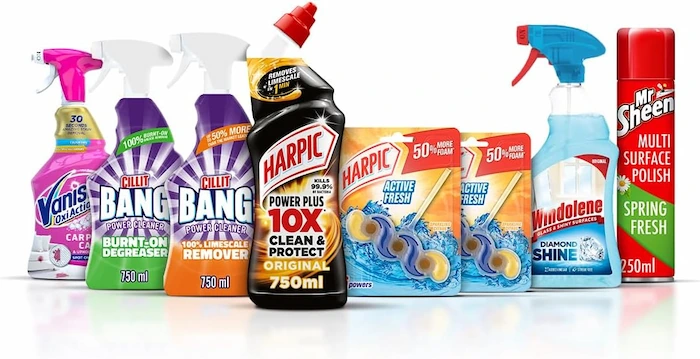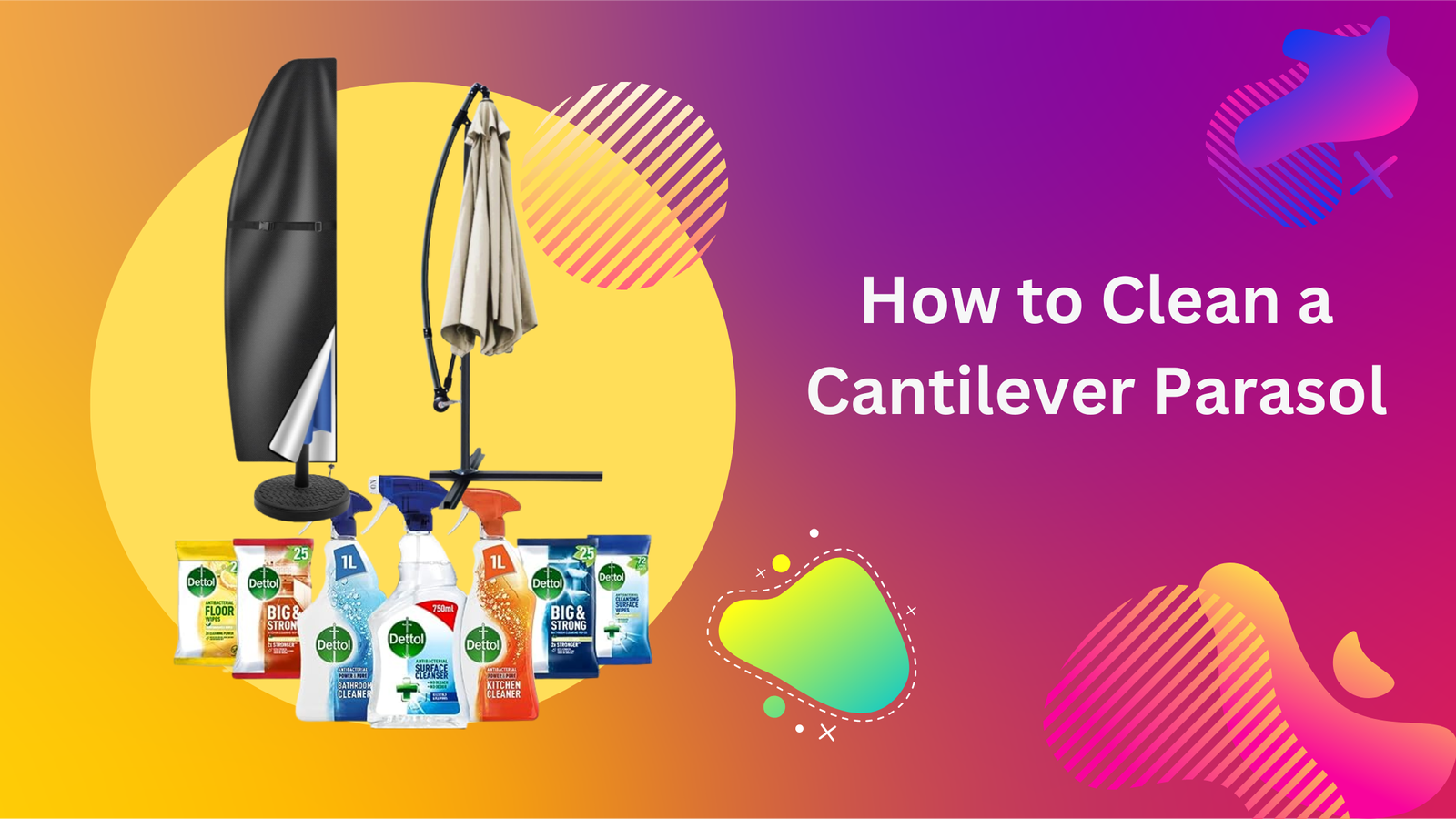How to Clean a Cantilever Parasol
Are you tired of your patio umbrella looking dull and dirty? Want to know the secret on how to clean a cantilever parasol? Look no further!
In this guide, we’ll walk you through the essential steps for maintaining your patio umbrella, ensuring it stays pristine all year round.
Regular cleaning is key for maintaining the lifespan of your patio umbrella and enhancing its appearance. By removing dirt, dust, and grime from the umbrella fabric, you can ensure that your garden furniture stays in great condition. So why wait? Let’s dive into the nitty-gritty details of how to clean your cantilever parasol with confidence.
Whether you’re dealing with stubborn stains on your vinyl patio umbrella or just need a routine refresh, we’ve got you covered. From choosing the right cleaning materials to tackling specific problem areas like mould, our expert tips will have your cantilever parasol looking as good as new in no time.
So roll up your sleeves and follow these step-by-step instructions for a deep clean that will leave your outdoor space shining bright!
Now let’s jump right into it and discover how easy it is to bring back that fresh and fabulous look to your beloved patio umbrella.
With just a few simple steps, you can restore your outdoor furniture set to its former glory. Start by preparing a cleaning solution and then follow the step-by-step process to clean your cantilever parasol.
Tips for How to Clean a Cantilever Parasol
Cleaning your cantilever umbrella is an essential step to keep it looking fresh and extend its lifespan on your patio. We will also provide useful tips to ensure a thorough and efficient cleaning process for your patio umbrella.
Cleaning the Canopy
It’s important to use gentle methods that won’t damage the patio umbrella fabric. Here are some steps you can follow
- To start, remove any loose debris such as leaves or twigs from the patio umbrella canopy in a single step.
- Fill a bucket with warm water and add a mild detergent suitable for delicate fabrics to clean your patio umbrella.
- Dip a soft-bristle brush or sponge into the soapy water and gently scrub the surface of the patio umbrella canopy in circular motions, taking care not to damage the fabric.
- Pay extra attention to areas with stains or dirt buildup on your patio umbrella, using more pressure if necessary.
- Rinse the patio umbrella canopy thoroughly with clean water until all soap residue is removed.
- Allow the canopy to air dry completely before closing or storing your cantilever umbrella.
Cleaning the Frame
The frame of your cantilever umbrella also requires regular cleaning to maintain its appearance and functionality. Follow these steps for an effective cleaning process:
- Use a soft cloth or sponge soaked in warm soapy water to wipe down the entire patio umbrella frame, including all moving parts.
- Pay attention to hard-to-reach areas such as joints and hinges of your patio umbrella, ensuring they are free from dirt and grime.
- For stubborn stains or spots on metal frames, you can use a mixture of baking soda and water applied with a cloth.
- Gently scrub affected areas until the stains are lifted, then rinse thoroughly with clean water.
- Dry off excess moisture with a clean towel or allow it to air dry naturally.
Suitable Cleaning Products and Tools
To ensure the best results when cleaning your cantilever umbrella, it’s important to use suitable cleaning products and tools. Here are some recommendations:
- Mild detergent: Opt for a gentle detergent specifically designed for delicate fabrics.
- Soft-bristle brush or sponge: Use these tools to scrub the canopy without causing damage.
- Baking soda: Effective for removing tough stains on metal frames.
Removing Dirt, Dust, and Stains
Dirt, dust, and stains can accumulate on your cantilever umbrella over time. Here are some additional tips to effectively remove them:
- Regular maintenance: Perform routine cleanings every few weeks to prevent dirt buildup.
- Spot cleaning: Address stains as soon as possible using the appropriate cleaning methods mentioned earlier.
- Protective covers: Consider using protective covers when your cantilever umbrella is not in use to minimize exposure to dirt and dust.
By following these tips and incorporating regular cleaning into your maintenance routine, you can keep your cantilever umbrella looking its best and ensure its longevity.

Protecting and Maintaining: Shading and Moving Your Parasol
Understanding the importance of proper shading techniques is crucial. Not only does it shield you from the sun’s harmful rays, but it also extends the lifespan of your outdoor umbrella. Here are some tips to ensure that you can enjoy your parasol for years to come.
To begin with, learning how to safely move and adjust your cantilever parasol without causing any harm is essential. When relocating your patio umbrella, always make sure that it is fully closed before attempting to move it.
This will prevent any accidental damage or injury. Avoid dragging the umbrella across rough surfaces as this can cause tears or scratches on the fabric.
Positioning your cantilever parasol in optimal locations for maximum shade coverage is another aspect to consider. It’s important to place your umbrella where it can provide adequate shade throughout the day while taking into account the movement of the sun.
By strategically positioning your parasol, you can create a comfortable outdoor space that remains cool even on the hottest days.
Preventing wind damage is also crucial in maintaining your cantilever parasol. Strong winds can easily topple an unsecured umbrella, leading to potential damage not only to the parasol itself but also to surrounding furniture and plants.
To anchor your patio umbrella securely, consider using weighted bases or ground anchors specifically designed for this purpose. This will ensure stability during gusty weather conditions.
When not in use, protecting your cantilever parasol from adverse weather conditions such as rain or winter elements is essential for its longevity. Ensure that you close and cover your umbrella during inclement weather to prevent water damage or exposure to extreme temperatures. Storing your outdoor furniture set in a dry area during winter months will help prolong its lifespan.
In terms of products that aid in maintaining and protecting cantilever parasols, there are several options available. Umbrella covers made from durable and weather-resistant materials can shield your parasol from the elements when it is not in use. Applying a fabric protector spray can help repel water and prevent staining.
Removing Green Mildew: Cleaning the Umbrella Frame
Green mildew can be a common issue that affects the frame of your cantilever parasol, but with the right methods and regular maintenance, you can keep your outdoor umbrella looking fresh and clean.
Identifying Green Mildew on the Frame
The first step in tackling green mildew is to identify its presence on your cantilever parasol’s frame. Look out for these common signs:
- Discolouration: Green or black patches appear on the surface of the frame.
- Musty Odor: A damp or musty smell emanating from the umbrella.
- Fuzzy Texture: A fuzzy or powdery texture when touching affected areas.
Once you’ve identified green mildew on your umbrella frame, it’s time to take action.
Effective Cleaning Methods for Different Materials
Cleaning methods may vary depending on the material used in your umbrella frame. Here are some effective techniques:
1. Aluminum Frames:
- Mix equal parts water and white vinegar in a spray bottle.
- Spray the solution onto the affected areas and let it sit for 10 minutes.
- Scrub gently with a soft brush or sponge.
- Rinse thoroughly with water and allow it to dry.
2. Steel Frames:
- Create a solution using warm water and mild dish soap.
- Dip a cloth or sponge into the soapy mixture and wipe down the affected areas.
- Rinse thoroughly with clean water.
- Dry completely to prevent any potential rusting.
3. Wooden Frames:
- Prepare a mixture of warm water and mild detergent.
- Gently scrub the affected areas with a soft brush or sponge.
- Rinse with water, ensuring not to oversaturate the wood.
- Allow the umbrella frame to air dry completely.
Natural Remedies for Green Mildew Removal
If you prefer natural remedies over harsh chemicals, consider these options:
- White Vinegar: Dilute white vinegar with water in a 1:1 ratio and spray it onto the affected areas. Leave it for 15 minutes before gently scrubbing and rinsing.
- Lemon Juice: Squeeze fresh lemon juice onto the mildew spots and let it sit for 10 minutes. Scrub with a brush or sponge, then rinse thoroughly.
- Baking Soda Paste: Create a paste using baking soda and water, apply it to the affected areas, and let it sit for 30 minutes. Scrub gently before rinsing off.
Importance of Regular Maintenance
Prevention is key. By implementing regular maintenance practices, you can reduce the likelihood of mildew growth:
- After each use, ensure that your umbrella is completely dry before closing and storing it.
- Regularly inspect your umbrella frame for any signs of mould or mildew growth.
- Clean your parasol at least once every few months using the appropriate cleaning methods mentioned above.
Maintaining the Base: Cleaning the Stand and Base
Regularly cleaning and maintaining the stand and base of your cantilever parasol is crucial for its longevity and functionality. Neglecting to do so can lead to dirt buildup, rust formation, water accumulation, and even mould growth.
Importance of Cleaning and Maintenance
The base of your cantilever parasol plays a significant role in providing stability and support. Over time, dirt, debris, and rust can accumulate on the surface, compromising its structural integrity. Regular cleaning not only enhances the aesthetic appeal but also ensures that your outdoor umbrella remains sturdy during windy conditions.
Removing Dirt, Debris, and Rust
Different types of umbrella bases require specific cleaning methods. Here are some techniques you can use to remove dirt, debris, and rust from common base materials:
- Metal Bases: For metal bases such as aluminium or steel, start by wiping away loose dirt using a soft cloth or brush. Mix warm water with mild dish soap and gently scrub the surface using a sponge or non-abrasive brush. Rinse thoroughly with clean water afterwards.
- Concrete Bases: Begin by sweeping away loose dirt or leaves from the concrete base using a broom or leaf blower. Next, create a mixture of equal parts white vinegar and water in a bucket. Dip a scrub brush into the solution and scrub away any stains or grime on the surface. Rinse off with water once finished.
- Plastic Bases: Plastic bases are relatively easy to clean. Start by rinsing off any loose dirt with a garden hose or bucket of water. Then apply a mild detergent solution onto the surface using a sponge or cloth. Scrub gently and rinse thoroughly to remove all soap residue.
When dealing with rust on metal bases, consider using a rust remover product specifically designed for outdoor furniture. Follow the manufacturer’s instructions carefully for best results.
Preventing Water Accumulation and Mold Growth
To prevent water accumulation and mould growth in the base of your cantilever parasol, follow these tips:
- Ensure that the base has proper drainage holes to allow water to flow out freely.
- Regularly inspect the base for any cracks or damage that may cause water seepage. Repair or replace as necessary.
- After rainfall, tilt the umbrella slightly to allow excess water to drain away.
- During wet seasons, consider covering the base with a waterproof cover when not in use.
- If mould does appear, mix equal parts vinegar and water in a spray bottle and apply it to affected areas. Scrub gently with a brush and rinse thoroughly.
Extending the Lifespan of Your Cantilever Parasol
By regularly cleaning and maintaining the stand and base of your cantilever parasol, you can significantly extend its lifespan. Proper care ensures that your outdoor umbrella remains stable, functional, and visually appealing for years to come.
Take pride in keeping your cantilever parasol clean so you can enjoy relaxing moments under its shade without worrying about any structural issues.
Remember, a little effort in maintaining the base goes a long way in preserving the overall quality of your outdoor umbrella!
Storing and Care: Keeping Your Parasol Intact
Proper storage techniques are essential to protect your cantilever parasol during the off-season. By following a few simple steps, you can ensure that your garden parasol remains in excellent condition for years to come.
Learn proper storage techniques to protect your cantilever parasol during the off-season.
There are a few key points to keep in mind. First, make sure you clean the parasol thoroughly before storing it. Use a mild soap solution and a soft brush to remove any dirt or debris. Rinse it well and allow it to dry completely before moving on to the next step.
Next, fold down the canopy of your cantilever parasol according to the manufacturer’s instructions. This will help minimize its size and make it easier to store. If possible, disassemble any detachable parts such as the base or pole for more compact storage.
Discover tips for folding, covering, and storing your outdoor umbrella to prevent damage.
Once your garden parasol is folded down, place a protective cover over it. This cover will shield it from dust, moisture, and other potential hazards while in storage. Ensure that the cover fits snugly around the folded canopy and secure it tightly with straps or ties.
When choosing a storage location for your cantilever parasol, opt for a cool and dry area away from direct sunlight. Excessive heat or humidity can cause damage over time. If space allows, consider storing it indoors or in a shed during harsh weather conditions.
Understand the importance of regular inspections and maintenance to ensure the longevity of your parasol.
Regular inspections are crucial for identifying any signs of wear or damage early on. Before using your outdoor umbrella each season, carefully examine all parts for loose screws, tears in the fabric, or any other issues that may need attention.
Addressing these problems promptly can prevent further damage and extend the lifespan of your cantilever parasol.
In addition to inspections, routine maintenance is essential. Clean your garden parasol regularly throughout the year, especially after exposure to rain or strong winds. Use a gentle cleanser and a soft cloth to wipe down the canopy, frame, and other components. This will help remove any dirt or stains and keep it looking its best.
Find out how to care for different materials used in cantilever parasols to avoid deterioration.
Cantilever parasols come in various materials such as aluminium, wood, or polyester fabric. Each material requires specific care to avoid deterioration.
For aluminium frames, clean them with mild soap and water using a non-abrasive sponge. Apply a protective wax coating once a year to maintain their shine and prevent corrosion.
Wooden frames should be treated with specialized oils or sealants designed for outdoor use. Regularly check for signs of rot or insect infestation, addressing any issues promptly.
Polyester fabric can be cleaned with a gentle detergent solution and rinsed thoroughly. Avoid using harsh chemicals that may cause discolouration or weaken the fabric’s integrity.
By following these storage techniques and caring for your cantilever parasol properly, you can ensure its longevity and enjoy many sunny days in your garden without worry of damage or deterioration.
Quick Cleaning Tips: Vacuuming and Spot Treating
Maintaining a clean canopy on your cantilever parasol is essential to ensure its longevity and keep it looking pristine. While extensive cleaning may seem like a daunting task, there are quick and effective methods such as vacuuming and spot treating that can help you tackle dust, dirt, and stains without much hassle.
Exploring Quick Cleaning Methods
Vacuuming is an excellent technique for removing loose debris like dust, leaves, or small twigs. Using a handheld vacuum cleaner with a brush attachment, gently run it over the surface of the canopy. The suction power will effortlessly lift away any accumulated dirt, leaving your parasol looking refreshed.
Spot treating is another handy method for addressing specific areas that require extra attention. Whether it’s a stubborn stain or a hard-to-reach spot, spot treating allows you to target those problem areas without having to clean the entire canopy thoroughly.
By using appropriate cleaning solutions or homemade remedies, you can effectively remove stains and blemishes from different types of fabric used in outdoor umbrellas.
Effective Removal of Dust, Dirt, and Stains
To remove dust from your cantilever parasol canopy using a vacuum cleaner:
- Attach the brush accessory to your handheld vacuum.
- Gently glide the brush across the surface of the fabric in long strokes.
- Pay special attention to crevices and folds where dust tends to accumulate.
- Repeat this process until all visible dust particles have been eliminated.
Spot-treating stains on your cantilever parasol require careful consideration of the fabric type:
- For mildew or mould stains on canvas fabric:
- Mix equal parts white vinegar and water in a spray bottle.
- Spray the solution directly onto the stained area.
- Use a soft-bristle brush to gently scrub the stain.
- Rinse thoroughly with clean water and allow it to air dry.
- For oil-based stains on polyester fabric:
- Apply a small amount of dishwashing liquid directly to the stain.
- Gently rub the detergent into the fabric using a soft cloth or sponge.
- Rinse off the soap residue with warm water.
- Allow the fabric to air dry completely.
Prolonging the Lifespan of Your Cantilever Parasol
Regular quick cleaning sessions not only keep your cantilever parasol looking its best but also help extend its lifespan. By promptly removing dust, dirt, and stains, you prevent them from settling deeper into the fabric and causing long-term damage.
Quick cleaning saves you time and effort compared to more extensive cleaning routines that may be required if dirt is left unattended for an extended period.
When to Clean Your Parasol: Timing is Key
Cleaning your cantilever parasol is an essential task that ensures its longevity and maintains its pristine appearance. By understanding when it’s necessary to clean your parasol, you can prevent any potential damages caused by neglect or harsh weather conditions. Let’s explore some key factors that will help you determine the right time for cleaning.
Weather Conditions and Usage Frequency
One crucial aspect to consider when deciding on the perfect timing for cleaning your cantilever parasol is the prevailing weather conditions. If you live in an area with frequent rain showers or high humidity levels, your parasol may require more regular cleaning than those in drier climates.
Take into account how often you use your outdoor umbrella. If it frequently shelters you from intense sunlight, dust, or other environmental debris, it will accumulate dirt faster and necessitate more frequent cleaning.
Signs That Indicate Thorough Cleaning
While routine maintenance such as wiping down the canopy and frame can keep your parasol looking tidy, there are signs that indicate a thorough cleaning is needed. Pay attention to these indicators:
- Stubborn Stains: If you notice stubborn stains on the fabric of your parasol that do not disappear with a simple wipe-down, it’s time for a deeper clean.
- Mould or Mildew Growth: The presence of mould or mildew can not only ruin the aesthetic appeal but also pose health risks. If you spot any signs of growth, immediate action is required.
- Foul Odors: Unpleasant odours emanating from your parasol could be indicative of accumulated dirt or mould growth.
- Reduced Functionality: If the opening and closing mechanisms become stiff or hindered due to dirt accumulation, a thorough cleaning will restore their functionality.
Seasonal Cleaning Schedules
To ensure consistent care for your cantilever parasol throughout the year, following a seasonal cleaning schedule can be immensely helpful. Consider the following guidelines:
- Spring Cleaning: As winter bids farewell and spring arrives, it’s an ideal time to give your parasol a comprehensive cleaning. Remove any dirt or debris accumulated during the colder months and inspect for any damages.
- Monthly Maintenance: During the summer months when your parasol is in frequent use, perform regular maintenance at least once a month. Wipe down the canopy, frame, and base to prevent dirt buildup.
- Fall Preparation: Before storing your parasol for the winter season, make sure to clean it thoroughly one last time. This will ensure that it remains in excellent condition during its hibernation period.
Preventing Permanent Stains and Damages
Timely cleaning of your cantilever parasol plays a crucial role in preventing permanent stains, mould growth, or other damages that may occur due to neglect. By promptly addressing any signs of staining or accumulation of dirt, you can maintain the longevity of your outdoor umbrella.
Remember that spending a few minutes regularly on cleaning can save you from more extensive efforts later on. So keep an eye out for signs that indicate it’s time to give your cantilever parasol some well-deserved attention.
Deep Cleaning: Scrubbing with Soap for a Thorough Clean
Regular cleaning is essential. While a quick wipe-down may suffice for day-to-day maintenance, there are times when a deeper clean is necessary to remove stubborn stains and dirt buildup.
To begin the deep cleaning process, you will need a suitable soap solution. Opt for a mild detergent or laundry detergent that is gentle on fabrics but effective in removing dirt and stains. Dilute the detergent in warm water to create a soapy solution that will effectively break down grime without causing damage.
Once you have prepared the soapy water, gather a soft cloth or sponge and dip it into the solution. Gently scrub the canopy of your cantilever parasol using circular motions, paying extra attention to areas with visible stains or heavy dirt accumulation.
The soft cloth or sponge will ensure that you do not damage the fabric while effectively removing dirt particles.
For more stubborn stains or hard-to-reach areas, consider using a soft brush with bristles. This will provide additional scrubbing power without causing harm to the material. Ensure that the brush you choose has soft bristles to prevent any abrasion on the surface of your parasol.
After thoroughly scrubbing the canopy with soap, rinse off any remaining residue by spraying it with clean water from a hose or using buckets of water poured gently over it. Make sure all traces of soap are removed as any leftover residue can attract more dirt over time.
If your cantilever parasol’s canopy is made from mould-resistant fabric, an additional step can be taken to eliminate any mould spores that may be present.
Create a bleach solution by diluting bleach in warm water, following the manufacturer’s instructions for proper ratios. Apply the bleach solution to the affected areas and let it sit for a few minutes before rinsing it off with clean water.
For particularly stubborn stains or heavily soiled canopies, you may consider using a washing machine. Check the care instructions provided by the manufacturer to ensure that machine washing is suitable for your specific parasol model.
Place the canopy in a laundry bag or pillowcase to protect it from potential damage caused by agitation during the wash cycle. Use a gentle cycle with cold water and mild detergent to prevent any unnecessary wear and tear.
Deep cleaning your cantilever parasol not only improves its appearance but also restores its functionality. By removing dirt buildup and stains, you can ensure that your outdoor umbrella continues to provide shade and protection for years to come.
Wrapping Up the Guide to Cleaning a Cantilever Parasol
Cleaning your cantilever parasol is essential to maintain its appearance and functionality. In this guide, we have covered some crucial steps and tips to help you keep your outdoor umbrella in optimal condition. Let’s recap what we’ve learned so far.
Regular maintenance is key. By following a few simple cleaning techniques, you can ensure that your parasol remains sturdy and attractive for years to come. Here are the main points to remember:
- Start by removing any loose dirt or debris from the canopy using a soft brush or broom. Gently sweep away leaves, twigs, and other particles that may have accumulated on the surface.
- Next, prepare a mixture of mild soap or detergent with warm water in a bucket. Dip a soft cloth or sponge into the soapy solution and gently scrub the canopy, paying close attention to any stains or spots.
- Rinse off the soap residue thoroughly with clean water using a hose or bucket. Make sure all traces of soap are removed as they can leave behind unsightly streaks on the fabric.
- To prevent mould and mildew growth, it’s important to let your cantilever parasol dry completely before closing it or storing it away. Leave it open in an airy location until fully dried.
- If you notice any stubborn stains that resist regular cleaning methods, consider using specialized fabric cleaners or stain removers designed for outdoor fabrics. Always follow the manufacturer’s instructions when applying these products.
By implementing these cleaning techniques regularly, you can keep your cantilever parasol looking its best throughout the seasons while ensuring its longevity.
Maintaining proper care for your outdoor umbrella goes beyond just cleaning it periodically; it involves protecting it from harsh weather conditions when not in use as well. Remember these additional tips:
- Close and secure your cantilever parasol during strong winds or storms to prevent damage.
- Use a protective cover when the parasol is not in use for an extended period, such as during the winter months.
- Store your parasol in a dry and sheltered area to avoid moisture buildup and potential mould growth.
Preventing Canopy Damage: Tips for Longevity
Protecting your cantilever parasol canopy from potential damage is crucial to ensure its longevity and maintain its aesthetic appeal. By following these preventive measures, you can avoid common causes of canopy damage, such as harsh weather conditions or improper handling.
One effective way to safeguard your canopy is by using protective covers or storage bags. These accessories provide an extra layer of defence against the elements when your parasol is not in use. Make sure to choose a cover that fits snugly around the entire structure, including the canopy and frame.
This will shield it from rain, sun exposure, dust, and debris. Consider opting for a cover made from durable materials that are resistant to tearing or fading over time.
Regular inspections are also essential in identifying early signs of wear or tear on the canopy fabric. Take some time every few weeks to examine the surface of the canopy closely.
Look out for any loose threads, small holes, or discolouration that may indicate damage. By catching these issues early on, you can address them promptly before they worsen.
When cleaning your cantilever parasol’s canopy, it’s important to use appropriate methods and products that won’t cause further harm. Start by removing any loose debris with a soft brush or cloth. Avoid using abrasive materials that could scratch or tear the fabric.
For light stains or dirt buildup, gently wipe the affected areas with a mild soap solution and rinse thoroughly with water afterwards. Ensure that the soap used is suitable for delicate fabrics.
Wooden frames are commonly found on cantilever parasols and require special care to prevent damage over time. To keep your wooden frame in optimal condition, regularly inspect it for signs of rotting or cracking caused by moisture exposure. Apply a wood sealant at least once a year to protect it from weather elements and extend its lifespan.
In addition to protecting your parasol when not in use, you should also take precautions during windy conditions. Strong winds can cause significant damage to the canopy if it is left open and unattended. Always close your parasol when not in use or when you anticipate inclement weather.
By following these preventive measures, you can ensure that your cantilever parasol’s canopy remains intact and visually appealing for years to come. Remember to regularly inspect, clean, and protect both the canopy fabric and wooden frame to extend their lifespan and enjoy many sunny days under your outdoor umbrella.
Drying and Reassembling: Caring for the Umbrella Fabric
Properly drying and reassembling your cantilever parasol after cleaning is essential to maintain its longevity and functionality. We’ll provide guidance on safely reassembling your outdoor umbrella without causing any damage or misalignment.
Drying Different Types of Fabric
Understanding the material is crucial. Whether you have a cloth, vinyl, or other type of fabric on your cantilever parasol, here are some effective methods to ensure proper drying:
- Air-drying: For most fabrics, air-drying is the safest method. Simply open up the umbrella and allow it to dry naturally in a well-ventilated area. Avoid direct sunlight as it may fade certain fabrics.
- Towel-drying: If you’re in a hurry or dealing with a particularly absorbent fabric like cotton or microfiber, use clean towels to gently blot away excess moisture before air-drying.
- Machine-drying: Some umbrella fabrics may be machine-washable and safe for tumble drying in low-heat settings. Always refer to the manufacturer’s instructions before attempting this method.
Preventing Mold Growth and Water Damage
During the drying process, it’s important to take precautions against mould growth and water damage that can compromise your cantilever parasol’s fabric:
- Thoroughly remove excess water: Before initiating the drying process, shake off any standing water from the umbrella canopy to prevent pooling or prolonged saturation.
- Proper ventilation: Choose an area with good air circulation for drying purposes. This helps prevent mould growth by ensuring moisture doesn’t get trapped within folds or crevices of the fabric.
- Avoid storing a damp umbrella: Ensure the fabric is completely dry before storing your cantilever parasol. Storing it while still damp can lead to mildew or mould formation, resulting in unpleasant odours and potential damage.
Safely Reassembling Your Outdoor Umbrella
When reassembling your cantilever parasol after cleaning, follow these steps to ensure a safe and seamless process:
- Check for any damages: Before reassembly, inspect the fabric for any tears, loose threads, or other damages that may require repair or replacement.
- Align the ribs: Align the ribs of the umbrella with their corresponding slots in the frame. Take care not to force anything, as this could cause misalignment or damage.
- Secure the canopy: Once aligned, secure the canopy by fastening any hooks or clips provided by the manufacturer. This ensures proper tension and stability.
- Test functionality: After reassembly, test the opening and closing mechanism of your cantilever parasol to ensure it operates smoothly without any obstructions or irregularities.
Proper care during drying and reassembly will help maintain the integrity of your cantilever parasol’s fabric and extend its lifespan. By following these guidelines, you can enjoy a clean and functional outdoor umbrella for years to come.
Conclusion: Wrapping Up the Guide to Cleaning a Cantilever Parasol
In conclusion, cleaning your cantilever parasol is essential for its longevity and maintaining its pristine appearance. By following the tips and techniques outlined in this guide, you can easily keep your parasol clean and well-maintained.
Throughout this guide, we discussed various aspects of cleaning a cantilever parasol. We provided tips for cleaning the umbrella itself, including removing green mildew from the frame and maintaining the base. We covered storing and caring for your parasol to ensure it remains intact.
We also shared quick cleaning tips such as vacuuming and spot treating, which can be handy for regular maintenance. Deep cleaning with soap was highlighted as an effective method for achieving a thorough cleaning when needed.
To prevent canopy damage and extend the lifespan of your parasol, we offered valuable insights on shading and moving techniques. Furthermore, we emphasized the importance of drying and reassembling the umbrella fabric properly to ensure its longevity.
Now that you have learned how to clean a cantilever parasol effectively, it’s time to put these practices into action! Remember that regular maintenance is key to keeping your parasol in top condition.
So go ahead, grab your cleaning supplies, and give your cantilever parasol some much-needed TLC. You’ll not only prolong its lifespan but also enjoy a beautiful shade during sunny days!
FAQs – How to Clean a Cantilever Parasol
How often should I clean my cantilever parasol?
It is recommended to clean your cantilever parasol at least once every season or whenever you notice dirt buildup or stains.
Can I use bleach or harsh chemicals to clean my cantilever parasol?
No, it is advisable to avoid using bleach or harsh chemicals as they can damage the fabric or frame of your parasol. Stick to mild soapy water solutions instead.
Can I leave my cantilever parasol outside during winter?
It is best to store your cantilever parasol indoors or in a protective cover during winter months to prevent damage from harsh weather conditions.
How do I remove stubborn stains from the fabric of my parasol?
For stubborn stains, try using a mixture of mild detergent and warm water. Gently scrub the stained area with a soft brush and rinse thoroughly.
Is it necessary to dismantle the parasol when cleaning?
While not always necessary, dismantling the parasol can make it easier to clean hard-to-reach areas and ensure a more thorough cleaning process.











